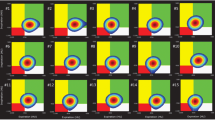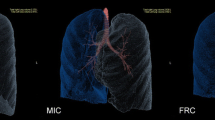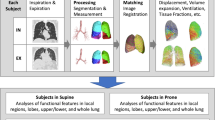Abstract
Dynamic chest radiography (DCR) identifies pulmonary impairments as decreased changes in radiographic lung density during respiration (Δpixel values), but not as scaled/standardized computed tomography (CT) values. Quantitative analysis correlated with CT values is beneficial for a better understanding of Δpixel values in DCR-based assessment of pulmonary function. The present study aimed to correlate Δpixel values from DCR with changes in CT values during respiration (ΔCT values) through a computer-based phantom study. A total of 20 four-dimensional computational phantoms during forced breathing were created to simulate both CT and projection images of the same virtual patients. The Δpixel and ΔCT values of the lung fields were correlated on a regression line, and the inclination was statistically evaluated to determine whether there were significant differences among physical types, sex, and breathing methods. The resulting conversion expression was also assessed in the DCR images of 37 patients. The resulting Δpixel values for 30/37 (81%) real patients, 6/7 (86%) normal controls, and 24/30 (80%) chronic obstructive pulmonary disorder patients were within the range of ΔCT values ± standard deviation (SD) reported in a previous study. In addition, no significant differences were detected for each condition of thoracic breathing, suggesting that the same regression line inclination values measured across the entire lung can be used for the conversion of Δpixel values, providing a quantitative analysis that can be correlated with ΔCT values. The developed conversion expression may be helpful for improving the understanding of respiratory changes using radiographic lung densities from DCR-based assessments of pulmonary function.







Similar content being viewed by others
References
Mathers CD, Loncar D. Projections of global mortality and burden of disease from 2002 to 2030. PLoS Med. 2006;28:209–24.
Aujesky D, Fine MJ. The pneumonia severity index: a decade after the initial derivation and validation. Clin Infect Dis. 2008;1(47 Suppl 3):S133–9. https://doi.org/10.1086/591394.
Kohno S, Seki M, Watanabe A, CAP Study Group. Evaluation of an assessment system for the JRS 2005: a-DROP for the management of CAP in adults. Intern Med. 2011;50(11):1183–91.
Mortensen J, Berg RMG. Lung scintigraphy in COPD. Semin Nucl Med. 2019;49(1):16–21.
Kawai H, Kawakami T, Tsujimoto M, et al. Prediction of pulmonary function after major lung resection using lung perfusion scintigraphy with single-photon emission computed tomography/computed tomography. Fujita Med J. 2020;6(2):37–48.
Magkanas E, Voloudaki A, Bouros D, et al. Pulmonary sarcoidosis: correlation of expiratory high-resolution CT findings with inspiratory patterns and pulmonary function tests. Acta Radiol. 2009;42(5):494–501.
Lee E, Seo JB, Lee HJ, et al. Quantitative assessment of global and regional air trappings using non-rigid registration and regional specific volume change of inspiratory/expiratory CT scans: studies on healthy volunteers and asthmatics. Korean J Radiol. 2015;16(3):632–40.
Gawlitza J, Trinkmann F, Scheffel H, et al. Time to exhale: additional value of expiratory chest CT in chronic obstructive pulmonary disease. Can Respir J. 2018;2018(7):1–9.
Maglione M, Montella S, Mollica C, et al. Lung structure and function similarities between primary ciliary dyskinesia and mild cystic fibrosis: a pilot study. Ital J Pediatr. 2017;43(1):34–42.
Kalef-Ezra J, Karantanas A, Tsekeris P. CT measurement of lung density. Acta Radiol. 1999;40(3):333–7.
Kauczor HU, Hast J, Heussel CP, et al. CT attenuation of paired HRCT scans obtained at full inspiratory/expiratory position: comparison with pulmonary function tests. Eur Radiol. 2002;12:2757–63.
Chen H, Chen R, Guan Y, et al. Correlation of pulmonary function indexes determined by low dose MDCT with spirometric pulmonary function tests in patients with chronic obstructive pulmonary disease. Am J Roentgenol. 2004;202(4):711–8.
Beek EJR, Dahmen AM, Stavngaard T, et al. Hyperpolarised 3He MRI versus HRCT in COPD and normal volunteers. PHIL trial. Eur Respir. 2009;34:1311–21.
Egger C, Gerard C, Vidotto N, et al. Lung volume quantified by MRI reflects extracellular-matrix deposition and altered pulmonary function in bleomycin models of fibrosis: effects of SOM230. Am J Physiol Lung Cell Mol Physiol. 2014;306(12):1064–77.
Roach DJ, Cremillieux Y, Serai SD, et al. Morphological and quantitative evaluation of emphysema in chronic obstructive pulmonary disease patients: a comparative study of MRI with CT. J Magn Reson Imaging. 2016;44:1656–63.
Yamamoto T, Kabus S, Lorenz C, et al. Pulmonary ventilation imaging based on 4-dimensional computed tomography: comparison with pulmonary function tests and SPECT ventilation images. Int J Radiat Oncol Biol Phys. 2014;90(2):414–22.
Yamashiro T, Moriya H, Tsubakimoto M, et al. Continuous quantitative measurement of the proximal airway dimensions and lung density on four-dimensional dynamic-ventilation CT in smokers. Int J Chron Obstruct Pulmon Dis. 2016;11:755–64.
Fujita H, Doi K, MacMahon H. Basic imaging properties of a large image intensifier—TV digital chest radiographic system. Investig Radiol. 1987;22:328–35.
Lam KL, Chan HP, MacMahon H, et al. Dynamic digital substruction evaluation of regional pulmonary ventilation with nonradioactive xenon. Invest Radiol. 1990;25:728–35.
Kiuru A, Svedstrom E, Kuuluvainen I. Dynamic imaging of pulmonary ventilation. Description of a novel digital fluoroscopic system. Acta Radiol. 1991;32:114–9.
Kiuru A, Svedstrom E, Korvenranta H. Dynamic pulmonary imaging: performance properties of a digital fluoroscopy system. Med Phys. 1992;19:467–73.
Tanaka R, Sanada S, Fujimura M, et al. Development of functional chest imaging with a dynamic flat-panel detector (FPD). Radiol Phys Technol. 2008;1:137–43.
Tanaka R. Dynamic chest radiography: flat-panel detector (FPD) based functional X-ray imaging. Radiol Phys Technol. 2016;9:139–53.
Tanaka R, Sanada S, Fujimura M, Yasui M, Tsuji S, Kayashi N, Okamoto H, Nanbu Y, Matsui O. Ventilatory impairment detection based on distribution of respiratory-included changes in pixel values in dynamic chest radiography: a feasibility study. Int J CARS. 2011;6(1):103–10.
Yamada Y, Ueyama M, Abe T, et al. Difference in the craniocaudal gradient of the maximum pixel value change rate between chronic obstructive pulmonary disease patients and normal subjects using sub-mGy dynamic chest radiography with a flat panel detector system. Eur J Radiol. 2017;92:37–44.
Tanaka R, Matsumoto I, Tamura M, et al. Comparison of dynamic flat-panel detector-based chest radiography with nuclear medicine ventilation-perfusion imaging for the evaluation of pulmonary function: a clinical validation study. Med Phys. 2020;47(10):4800–9.
Tanaka R, Tani T, Nitta N, et al. Pulmonary function diagnosis based on respiratory changes in lung density with dynamic flat-panel detector imaging: an animal-based study. Invest Radiol. 2018;53(7):417–23.
Tanaka R, Tani T, Nitta N, Tabata T, Matsutani N, Muraoka S, Yoneyama T, Sanada S. Pulmonary function diagnosis based on respiratory changes in lung density with dynamic flat-panel detector imaging: an animal-based study. Invest Radiol. 2018;53(7):417–23.
Abadi E, Segars WP, Tsui BMW, et al. Virtual clinical trials in medical imaging: a review. J Med Imaging. 2020;7(4):042805. https://doi.org/10.1117/1.JMI.7.4.042805.
Segars WP, Sturgeon G, Mendonca S, et al. 4D XCAT phantom for multimodality imaging research. Med Phys. 2010;37(9):4902–15.
Segars WP, Mahesh M, Beck TJ, et al. Realistic CT simulation using the 4D XCAT phantom. Med Phys. 2008;35:3800–8.
Segars WP, Tsui BMW. MCAT to XCAT: the evolution of 4-D computerized phantoms for imaging research. Proc IEEE Inst Electr Electron Eng. 2009;97(12):1954–68.
Segars WP, Bond J, Frush J, Hon S, Eckersley C. Population of anatomically variable 4D XCAT adult phantoms for imaging research and optimization. Med Phys. 2013;40(4):043701 (p 11).
Tanaka R, Samei E, Segars WP, Abadi E, Matsumoto I, Tamura M, Takata M, Yamashiro T. Preoperative assessment of pleural invasion and adhesion of lung tumors with dynamic chest radiography: a virtual clinical trial. Med Phys. 2020;48(4):1616–23.
Visible Human Male and Female datasets, National Library of Medicine. http://www.nlm.nih.gov/research/visible/visible_human.html.
ICRU. International commission on radiation units and measurement, photon, electron, proton and neutron interaction data for body tissues. ICRU Report No 46. Bethesda: ICRU; 1992.
Obesity: preventing and managing the global epidemic. Report of a WHO Consultation on obesity. Geneva, 3–5, June 1997.
Suzuki K, Abe H, MacMahon H, Doi K. Image-processing technique for suppressing ribs in chest radiographs by means of massive training artificial neural network (MTANN). IEEE Trans Med Imaging. 2006;25:406–16.
Knapp J, Worrell S. Feature based neural network regression for feature suppression. U.S. Patent Number, 204,292 B2, June 12, 2012.
Olaf R, Fischer P, Brox T. U-net: convolutional networks for biomedical image segmentation. In: International conference on medical image computing and computer-assisted intervention. Cham: Springer; 2015.
Kitahara Y, Tanaka R, Holger R, Oda H, Mori K, Kasahara K, Matsumoto I. Lung segmentation based on a deep learning approach for dynamic chest radiography. In: Proc. SPIE 10950. 2019.
Skourt BA, Hassani AE, Majda A. Lung CT image segmentation using deep neural networks. Proc Comput Sci. 2018;127:109–13.
Pauwels RA, Buist AS, Calverley PM, Jenkins CR, Hurd SS, GOLD Scientific Committee. Global strategy for the diagnosis, management, and prevention of chronic obstructive pulmonary disease. NHLBI/WHO Global Initiative for Chronic Obstructive Lung Disease (GOLD) Workshop summary. Am J Crit Care Respir Med. 2001;163:1256–76.
Acknowledgements
The authors sincerely thank the staff from the departments of respiratory medicine, thoracic surgery, and radiology at Kanazawa University Hospital for providing the data described above.
Funding
The devices used in our clinical study were also provided by Konica Minolta, Inc., Tokyo, Japan. This work was supported in part by Grants-in-Aid from the Ministry of Education, Culture, Sports, Science, and Technology (MEXT) KAKENHI (#16K10271, 19K12841), the Shimadzu Corporation for Science and Technology, and the Tateishi Science and Technology Foundation.
Author information
Authors and Affiliations
Corresponding authors
Ethics declarations
Conflict of interest
Our institution has received a research grant from Konica Minolta, Inc., Tokyo, Japan.
Informed consent
The present study was approved by the institutional review board of Kanazawa University (registration number 1729). Written informed consent was obtained from all the participants.
Additional information
Publisher's Note
Springer Nature remains neutral with regard to jurisdictional claims in published maps and institutional affiliations.
About this article
Cite this article
Sugiura, T., Tanaka, R., Samei, E. et al. Quantitative analysis of changes in lung density by dynamic chest radiography in association with CT values: a virtual imaging study and initial clinical corroboration. Radiol Phys Technol 15, 45–53 (2022). https://doi.org/10.1007/s12194-021-00648-w
Received:
Revised:
Accepted:
Published:
Issue Date:
DOI: https://doi.org/10.1007/s12194-021-00648-w




